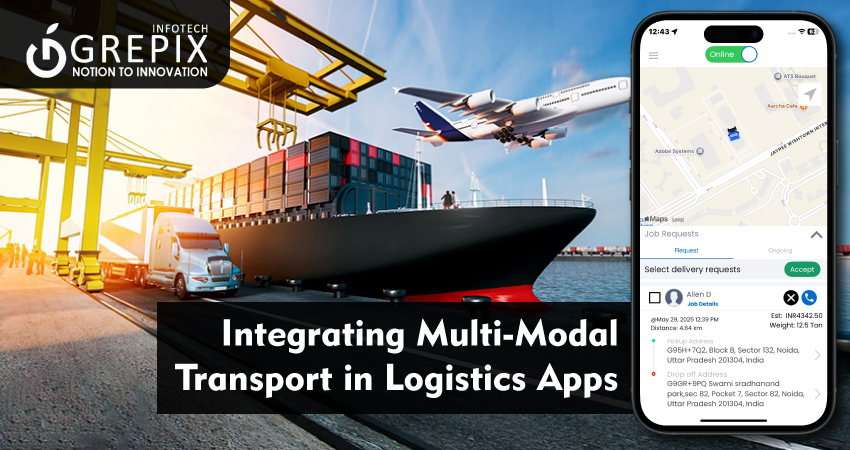Integrating Multi-Modal Transport in Logistics Apps
Multi-modal transport logistics apps are redefining how supply chains operate in the modern world. These platforms integrate transport systems combining air, road, rail, and sea within one unified system. With global e-commerce on the rise and logistics networks becoming increasingly complex, logistics multimodal solutions ensure flexibility, resilience, and robust cost control. By deploying intermodal delivery apps, companies transform their delivery processes, achieve competitive advantages, and respond faster to market demands.
Integrating multi-modal transport logistics apps revolutionizes supply chains by combining rail, road, air, and sea modes for seamless deliveries and increased visibility. Businesses using logistics multimodal solutions report improved operational efficiency, lower transportation costs, and better customer experiences. Case studies from global leaders like IKEA and Amazon demonstrate the power of intermodal delivery apps to streamline shipping, adapt instantly to changing requirements, and achieve sustainability goals. This article explores the definition, benefits, integration challenges, and future scope of multi-modal transport logistics apps, providing actionable steps and expert strategies for successful adoption.
Definition of Multi-Modal Transport
What Is a Multi-Modal Transport Logistics App?
A multi-modal transport logistics app is a digital platform that enables goods to be shipped through a sequence of transport modes road, rail, air, or sea under one contract or workflow.
- This integration ensures smooth transitions, real-time tracking, and event-based notifications for each shipment leg.
- Intermodal delivery apps go a step further, providing users with end-to-end visibility, automated document management, and predictive ETAs across all modes.
How Do Multi-Modal Logistics Apps Work?
- Route Planning: Algorithms determine the fastest, most cost-effective combination of transport modes.
- Shipment Consolidation: Orders are grouped for optimal load and fewer trips, reducing costs and environmental impact.
- Real-Time Tracking: Integrated IoT sensors and map APIs deliver up-to-minute status.
- Multi-Channel Sync: Inventory levels, shipping docs, and invoices are aligned for instant access by all stakeholders
Benefits of Logistics Multimodal Solutions
Key Advantages of Integration
- Operational Efficiency: Multi-modal transport logistics apps reduce idle time, consolidate shipments, and synchronize warehouse and delivery schedules.
- Cost Reduction: Shippers cut transportation expenses through optimized capacity use and dynamic rate shopping.
- Customer Satisfaction: Timely, accurate deliveries powered by robust tracking boost trust and loyalty.
Real-World Examples
- IKEA’s Global Supply Chain: IKEA combines road, rail, and maritime modes, supported by logistics multimodal solutions, to ship flat-pack furniture optimally. Each mode is chosen for speed and cost, enhancing global reach.
- Amazon’s Intermodal Network: Amazon’s vast logistics app platform harnesses air, rail, and road for fast, reliable two-day deliveries worldwide.
- Tennessee Automotive Manufacturing: Manufacturers rely on integrated transport systems—using rail for raw materials and road for finished vehicles automated by custom logistics software.
- Choose SmartNow Logistics App: This case study shows how integrating order booking, real-time routing, and multi-drop delivery created seamless intermodal delivery experiences for users.
- Kargologic Management App: By integrating Google Maps and diverse vehicle options, customers choose optimal transport types for each shipment, supported by instant fare calculations and digital invoicing.
Enhanced Visibility & Sustainability
- Consolidation and Route Optimization: lower emission and fuel use.
- Integrated shipment tracking: ensures visibility from dispatch to delivery.
- User-centric dashboards: support proactive issue management for every leg of the journey.
Integration Challenges
Barriers to Implementation
- System Interoperability: Connecting legacy transport systems with advanced logistics apps can require API customizations, data mapping, and standardization.
- Data Silos: Disparate systems make unified tracking and status updates difficult without seamless platform integration.
- Regulatory Compliance: Ensuring automated documentation meets varying country and carrier standards is complex.
- Real-Time Data Delays: Unreliable connectivity or lack of IoT sensors may disrupt tracking and ETA predictions.
Solutions and Strategies
- Deploy unified Transportation Management Systems (TMS) to automate workflows for all shipment modes.
- Invest in robust API-led integrations for instant sync with WMS, ERP, and carrier systems.
- Use AI-driven analytics for predictive rate shopping, SLA benchmarking, and dynamic carrier selection.
- Ensure security protocols and compliance are baked into every transaction and document flow.
Role of Multi-Modal Transport Logistics Apps
How Apps Enable Seamless Integration
- All-in-One Dashboards: Users book, track, and manage shipments across modes in a single interface.
- Automated Document Flow: Apps generate bills of lading, proof of delivery, and customs forms based on mode, country, and carrier.
- Intelligent Routing: Apps optimize delivery through real-time traffic, carrier availability, and cost analysis.
- Mobile Synchronization: Customers and drivers share updates and payments on the go, reducing manual errors and speeding up operations.
Real Case Studies
- Neurored Multimodal TMS & SCM: Enterprises manage sea, air, road, and rail transport globally on a single app, streamlining real-time tracking and reporting.
- Choose SmartNow: Businesses use this intermodal delivery app for multi-drop routing, easy payments and seamless carrier selection.
- Infosys Multi-Modal Logistics Enterprise: A dynamic pricing solution implemented via intermodal logistics software enabled agile, data-driven mode selection for improved supply chain performance.
Latest Statistics
- 60% of European logistics firms have deployed multi-modal transport logistics apps by 2025, up from 37% in 2022.
- Over 30% reduction in delivery times reported by users switching to integrated logistics multimodal solutions.
- 52% of businesses see improved customer satisfaction with real-time, multi-modal tracking.
Future Scope of Logistics Multimodal Solutions
Trends Shaping Integration
- AI & Machine Learning: Predictive algorithms improve mode selection, rate shopping, and ETA calculation for intermodal delivery apps.
- IoT Sensors: Every shipment leg is monitored for location, condition, and performance.
- Sustainable Mobility: Companies prioritize lower emissions by optimizing network flow, vehicle types, and consolidation.
- Blockchain for Supply Chain: Secure, traceable transactions support transparency across transport systems.
Innovations to Watch
- Smart contracts enabling instant carrier onboarding and dynamic payment reconciliation.
- Enhanced green corridors and multimodal integrations for sustainable transport networks in urban logistics.
- Mobile-first intermodal delivery app designs prioritizing user experience, payment automation, and instant feedback for continuous improvement.
Conclusion
Multi-modal transport logistics apps and integrated transport systems are revolutionizing modern supply chains enabling higher efficiency, lower costs, and enhanced customer experiences. By adopting logistics multimodal solutions, companies can flexibly coordinate shipments across road, rail, air, and sea, leveraging real-time tracking and intelligent routing for optimal results. With robust intermodal delivery app integration, businesses proactively address challenges, automate documentation, and delight customers with timely deliveries. The future is digital, data-driven, and sustainable investing in multi-modal transport logistics app integration is a strategic must for every logistics leader.
FAQs
1. What is a multi-modal transport logistics app?
A multi-modal transport logistics app allows goods to be shipped via several transport modes road, rail, air, and sea streamlined into a single contract or workflow for efficient, cost-effective shipping.
2. What are the main benefits of integrating transport systems?
Integrated transport systems enable faster deliveries, reduced costs, higher visibility, and better adaptability to changing market demands.
3. How do logistics multimodal solutions improve sustainability?
By optimizing routes, consolidating shipments, and choosing the ideal transport mix, these solutions reduce fuel use, emissions, and overall environmental impact.
4. Can small businesses use intermodal delivery apps?
Yes! Many intermodal delivery apps provide scalable features and pay-as-you-go pricing, allowing small businesses to start simple and expand as needed.
5. What are the top challenges in integrating multi-modal transport systems?
Key hurdles include system interoperability, fragmented data, regulatory compliance, and ensuring real-time updates all of which require robust platform features and smart planning.







